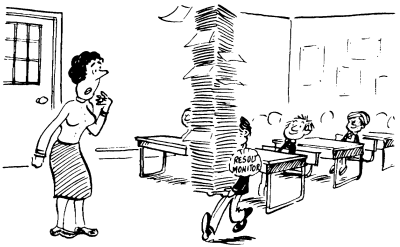|
The Effects of Chance
Similar chance situations occur in everyday life. What is
sometimes meant to be a well-planned event can turn into disaster
if things are left to chance.
Whose Report?
Let us look at the possible effect of chance in school. In one
class there are three people whose surname is Smith: A. Smith, B.
Smith and C. Smith.
The class teacher is somewhat absent-minded and is not very
careful when he puts their reports into envelopes at the end of'
term.
- What is the chance that he will get the right report
in the correct envelope for each pupil?
You can try this out a number of times and see what happens.
This is called a SIMITLATION.
You will each need a copy of page R1.
Your teacher will divide the class into groups of 4. In each
group one person is to be the teacher, and the others are A.
Smith, B. Smith and C. Smith. Make certain you know who you are
meant to be and don't change.
Each group needs three identical slips of paper, one labelled
A, the second B and the third C. Fold them exactly the same way
so that the letter does not show.
The teacher then shuffles the papers. A. Smith chooses one,
without looking. B. Smith then chooses another, without looking,
and C. Smith takes the last one.
- Look at the letters and record the results in
Table 5 on page R1. Under each column headed A, B or C,
record the letter on the piece of paper received by that
person.
For example, if A gets report B, B gets report A and C gets
his own. then the first line of your table would look like this:
| Trial
Number |
Recieved
by |
Number
getting right report |
| A |
B |
C |
| 1 |
B |
A |
C |
1 |
Notice that each letter must appear once and only once in each
row.
In the example above, only C got the right report. so the last
column contains a 1.
- In the last column of Table 5 record how many
people received the right report each time.
- Fold the papers over again, all in the same way,
hand them back to the 'teacher', and repeat the process
until you have 15 results.
Collecting Results Together
- How often did you get no (0) correct results? Put
this number in the first space in the column headed '
Group
results: Frequency' in Table 6 on page R1.
How often did you get one correct result? Put
this number under the one you have just recorded.
Complete this column on Table 6. The total should
come to 15.
Did you ever get exactly two letters correct? Why
not? Write a statement under Table 6 to explain why it is
impossible to get exactly two correct.
Let us look at the results more closely.
You had 15 goes. So did J. Jones. His version of Table 6
looked like this:
Table 1 - Summarized results
for J. Jones
To find the numbers to complete column 3, J. Jones reasoned
like this: 1 had 0 correct results four times out of 15 goes.
As a proportion of the total of 15, this is:
4/15 = 0.2666 = 0.27 to 2 decimal
places
He completed the rest of the column in the same way.
- Complete column 3 of Table 6.
- Collect all the results for each group in your
class. Enter these under the heading '
Class results:
Frequency'. Work out the proportions for your class, and
record them in the last column of Table 6.
Look at the two columns of figures headed 'Proportion'.
- Why do you think the two columns do not show the
same figures? If the simulation were carried out another
120 times, what do you think would happen to the
proportions?

Which Order?
Look back at your results in Table 5. Where there are three
correct, the order of the letters was A B C.
Look at the other results.
- Write down all the different arrangements of the
letters A, B and C that occur in your answers.
- Can you find any other arrangements that don't
appear in your table? If so, write them down. There
should be six altogether.
|